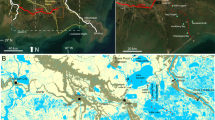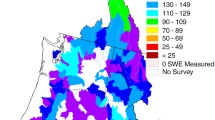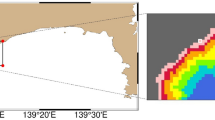Abstract
While the physical forcing mechanisms that govern the outflows of major rivers throughout the world are well documented in the literature, comparably less research has been done to examine the mechanisms that govern the contributions of small rivers and streams to coastal ocean systems. These rivers and streams provide a direct means for the transport of anthropogenic and terrigenous materials from watersheds to coastal oceans. This study describes the temporal and spatial variability of freshwater plumes from Kaneohe Stream, Hawaii, USA, after storm events in the Kaneohe Bay watershed. Freshwater plumes were examined using a combination of fixed moorings, synoptic shipboard surveys, and lagrangian surface drifters. Data sets were collected over the course of 19 months from August 2005 to March 2007 with particular attention paid to storms during the boreal winters. Stream discharge and duration were found to exert a primary control on plume persistence in the southern Kaneohe Bay system. Time series data show a strong coherence between wind forcing and surface currents, which, in combination with data derived from shipboard and aerial surveys, indicate that the spatial variability of freshwater plumes is primarily determined by atmospheric forcing.







Similar content being viewed by others
References
Bathen, K.H. 1968. A descriptive study of the physical oceanography of Kaneohe Bay, Oahu, Hawaii. Report no. 14. Honolulu, HI: Hawaii Institute of Marine Biology.
Berdeal, I.G., B.M. Hickey, and M. Kawase. 2002. Influence of wind stress and ambient flow on a high discharge river plume. Journal of Geophysical Research 107(C9):3130–3154.
DeCarlo, E.H., V.L. Beltran, and M.S. Tomlinson. 2004. Composition of water and suspended sediment in streams of urbanized subtropical watersheds in Hawaii. Applied Geochemistry 19(7):1011–1037.
DeCarlo, E.H., D.J. Hoover, C.W. Young, R.S. Hoover, and F.T. Mackenzie. 2007. Impact of storm runoff from tropical watershed on coastal water quality and productivity. Applied Geochemistry 22(8):1777–1797.
Devlin, M., J. Waterhouse, J. Taylor, and J. Brodie. 2001. Flood plumes in the Great Barrier Reef: Spatial and temporal patterns in composition and distribution. Research Publication no. 68. Townsville, Australia: Great Barrier Reef Marine Park Authority.
Drake, P.T., M.A. McManus, and C.D. Storlazzi. 2005. Local wind forcing of the Monterey Bay area inner shelf. Continental Shelf Research 25:397–417.
Fagan, K.E., and F.T. Mackenzie. 2007. Air–sea CO2 exchange in a subtropical estuarine–coral reef system, Kaneohe Bay, Oahu, Hawaii. Marine Chemistry 106(1–2):174–191.
Fischer, H.B., E.J. List, R.C.Y. Koh, J. Imberger, and N.H. Brooks. 1979. Mixing in inland and coastal waters. New York: Academic.
Fong, D.A., and W.R. Geyer. 2001. Response of a river plume during an upwelling favorable wind event. Journal of Geophysical Research 106(C1):1067–1084.
Fong, D.A., W.R. Geyer, and R.P. Signell. 1997. The wind-forced response on a buoyant coastal current: Observations of the western Gulf of Maine plume. Journal of Marine Systems 12:69–81.
Forget, P., P. Fraunié, and S. Ouillon. 2001. Visible and microwave signatures of river plumes in microtidal seas. Proceedings of the Geoscience and Remote Sensing Symposium, 2001. IGARSS’01. 1:278–280.
Garvine, R.W.. 1987. Estuary plumes and fronts in coastal waters: a layer model. Journal of Physical Oceanography 17:1877–1896.
Gaston, T.F., T.A. Schlacher, and R.M. Connolly. 2006. Flood discharges of a small river into open coastal waters: Plume traits and material fate. Estuarine, Coastal and Shelf Science 69:4–9.
Geyer, W.R., P. Hill, T. Milligan, and P. Traykovski. 2000. The structure of the Eel River plume during floods. Continental Shelf Research 20:1067–2093.
Giambelluca, T.W., M.A. Nullet, and T.A. Schroeder. 1986. Rainfall atlas of Hawaii. Hawaii: Department of Land and Natural Resources.
Harris, F.J.. 1978. On the use of windows for harmonic analysis with the discrete Fourier transform. Proceedings of the Institute of Electrical and Electronic Engineers 66:51–83.
Hearn, C.J. 1999. Wave-breaking hydrodynamics within coral reef systems and the effect of changing relative sea level. Journal of Geophysical Research 104(C12):30007–30019.
Hill, A.E. 1998. Buoyancy effects in coastal and shelf seas. In The sea, eds. K.H. Brink, and A.R. Robinson, 21–62. New York: Wiley.
Hitchcock, G.L., W.J. Wiseman Jr., W.C. Boicourt, A.J. Mariano, N. Walker, T.A. Nelsen, and E. Ryan. 1997. Property fields in an effluent plume of the Mississippi River. Journal of Marine Systems 12:109–126.
Hoover, D. 2002. Fluvial nitrogen and phosphorus in Hawaii: Storm runoff, land use, and impacts on coastal waters. Ph.D. dissertation, University of Hawaii at Manoa, Honolulu, Hawaii.
Hoover, R.S., D. Hoover, M. Miller, M.R. Landry, E.H. DeCarlo, and F.T. Mackenzie. 2006. Zooplankton response to storm runoff in a tropical estuary: bottom-up and top-down controls. Marine Ecology Progress Series 318:187–201.
Huret, M., I. Dadou, F. Dumas, P. Laxure, and V. Garçon. 2005. Coupling physical and biogeochemical processes in the Río de la Plata plume. Continental Shelf Research 25:629–653.
Kimmerer, W.J., T.W. Walsh, and J. Hirota. 1982. The effects of sewage discharge on a wind-induced plume front. In Estuaries and nutrients, eds. B.J. Neilson, and L.E. Cronin. Clifton, NJ: Humana.
Lowe, R.J., J.L. Falter, S.G. Monismith, and M.J. Atkinson. 2006. Circulation in a coral reef-lagoon system: Kaneohe Bay, Hawaii. In Proceedings of the Sixth International Symposium on Stratified Flows. Perth, WA, Australia.
McManus, M.A., A.L. Alldredge, A.H. Barnard, E. Boss, J.F. Case, T.J. Cowles, P.L. Donaghay, L.B. Eisner, D.J. Gifford, C.F. Greenlaw, C.M. Herren, D.V. Holliday, D. Johnson, S. MacIntyre, D.M. McGehee, T.R. Osborn, M.J. Perry, R.E. Pieper, J.E.B. Rines, D.C. Smith, J.M. Sullivan, M.K. Talbot, M.S. Twardowski, A. Weidemann, and J.R. Zaneveld. 2003. Characteristics, distribution and persistence of thin layers over a 48 hour period. Marine Ecology Progress Series 261:1–19.
Milliman, J.D., and J.P.M. Syvitski. 1992. Geomorphic/tectonic control of sediment discharge to the ocean: The importance of small mountainous rivers. The Journal of Geology 100:525–544.
Pawlowicz, R., B. Beardsley, and S. Lentz. 2002. Classical tidal harmonic analysis including error estimates in MATLAB using T_TIDE. Computers and Geosciences 28:929–937.
Piñones, A., A. Valle-Levinson, D.A. Narváez, C.A. Vargas, S.A. Navarette, G. Yuras, and J.C. Gastilla. 2005. Wind-induced diurnal variability in river plume motion. Estuarine, Coastal and Shelf Science 65:513–525.
Presto, M.K., A.S. Ogston, C.D. Storlazzi, and M.E. Field. 2006. Temporal and spatial variability in the flow and dispersal of suspended-sediment on a fringing reef flat, Molokai, Hawaii. Estuarine, Coastal and Shelf Sciences 67:67–81.
Ringuet, S., and F.T. Mackenzie. 2005. Controls on nutrient and phytoplankton dynamics during normal flow and storm runoff conditions, Southern Kaneohe Bay, Hawaii. Estuaries 28(3):327–337.
Savenije, H.H.G. 2005. Salinity and tides in alluvial estuaries. Elsevier: Amsterdam.
Scheinberg, R.D. 2004. Food web structure and trophic dynamics of a subtropical plankton community, with an emphasis on appendicularians. Ph.D. dissertation, University of Hawaii at Manoa, Honolulu, Hawaii.
Smith, S.V., W.J. Kimmerer, E.A. Laws, R.E. Brock, and T.W. Walsh. 1981. Kaneohe bay sewage diversion experiment: Perspectives on ecosystem responses to nutritional perturbation. Pacific Science 35(4):279–395.
Steinhilper, F.A. 1970. Particulate organic matter in Kaneohe Bay, Oahu, Hawaii. M.S. Thesis, University of Hawaii at Manoa, Honolulu, Hawaii.
Tomlinson, M.S., and E.H. DeCarlo. 2003. The need for high resolution time series data to characterize Hawaiian streams. Journal of the American Water Resources Association 39(1):113–123.
Thompson, R.O.R.Y. 1979. Coherence significance levels. Journal of Atmospheric Sciences 36:2020–2021.
US Census Bureau, 2006. (Various years). Census report.
Warrick, J.A., and D.A. Fong. 2004. Dispersal scaling from the world’s rivers. Geophysical Research Letters 21:L04301.
Washburn, L., K.A. McClure, B.H. Jones, and S.M. Bay. 2003. Spatial scales and evolution of stormwater plumes in Santa Monica Bay. Marine Environmental Research 56:103–125.
Wiseman, W.J. Jr., and R.W. Garvine. 1995. Plumes and coastal currents near large river mouths. Estuaries 18(3):509–517.
Yankovsky, A.E., and D.C. Chapman. 1997. A simple theory for the fate of buoyant coastal discharges. Journal of Physical Oceanography 27:1386–1401.
Acknowledgments
We wish to thank Brock Woodson and Brian McLaughlin for valuable assistance with field operations and data analysis, Yannis Papastamatiou, Rachel Solomon, Melinda Swanson, and Jeff Sevadjian for help with instrument deployment and recovery, Mike Rappé for generous use of instrumentation, Joe Reich for providing the Alyce C as a research platform, and the staff and management of the Hawaii Institute of Marine Biology for providing support for the field operations conducted during this study. We are most grateful to two anonymous reviewers for their insightful comments and suggestions that greatly improved the presentation and content of the paper. This paper is funded by a grant/cooperative agreement from the National Oceanic and Atmospheric Administration, Project no. R/EL-33, which is sponsored by the University of Hawaii Sea Grant College Program, SOEST, under Institutional Grant no. NA05OAR4171048 from NOAA Office of Sea Grant, Department of Commerce. The views expressed herein are those of the author(s) and do not necessarily reflect the views of NOAA or any of its subagencies. UNIHI-SEAGRANT-JC-06–14. This is contribution 7109 from the School of Ocean and Earth Science and Technology (SOEST), University of Hawaii at Manoa, Honolulu, HI, 96822, USA.
Author information
Authors and Affiliations
Corresponding author
Rights and permissions
About this article
Cite this article
Ostrander, C.E., McManus, M.A., DeCarlo, E.H. et al. Temporal and Spatial Variability of Freshwater Plumes in a Semienclosed Estuarine–Bay System. Estuaries and Coasts: J CERF 31, 192–203 (2008). https://doi.org/10.1007/s12237-007-9001-z
Received:
Revised:
Accepted:
Published:
Issue Date:
DOI: https://doi.org/10.1007/s12237-007-9001-z




